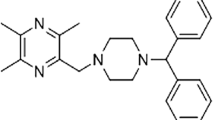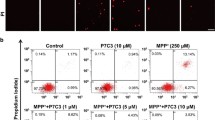Abstract
Amounting evidences demonstrated that Rho/Rho-associated kinase (ROCK) might be a novel target for the therapy of Parkinson’s disease (PD). Recently, we synthesized L-F001 and revealed it was a potent ROCK inhibitor with multifunctional effects. Here we investigated the effects of L-F001 in PD models. We found that L-F001 potently attenuated 6-OHDA-induced cytotoxicity in PC12 cells and significantly decreased intracellular reactive oxygen species (ROS), prevented the 6-OHDA-induced decline of mitochondrial membrane potential and intracellular GSH levels. In addition, L-F001 increased Akt and GSK-3beta phosphorylation and induced the nuclear Nrf2 and HO-1 expression in a time- and concentration-dependent manner. Moreover, L-F001 restored the levels of p-Akt and p-GSK-3beta (Ser9) as well as HO-1 expression reduced by 6-OHDA. Those effects were blocked by the specific PI3K inhibitor, LY294002, indicating the involvement of Akt/GSK-3beta pathway in the neuroprotective effect of L-F001. In addition, L-F001 significantly attenuated the tyrosinehydroxylase immunoreactive cell loss in 1-methyl-4-phenyl-1,2,3,6 tetrahydropyridine (MPTP)-induced mice PD model. Together, our findings suggest that L-F001 prevents 6-OHDA-induced cell death through activating Akt/GSK-3beta and Nrf2/HO-1 signaling pathway and attenuates MPTP-induced dopaminergic neuron toxicity in mice. L-F001 might be a promising drug candidate for PD.






Similar content being viewed by others
References
Dauer W, Przedborski S (2003) Parkinson’s disease: mechanisms and models. Neuron 39:889–909
Hirsch E, Graybiel AM, Agid YA (1988) Melanized dopaminergic neurons are differentially susceptible to degeneration in Parkinson’s disease. Nature 334:345–348
Barnham KJ, Masters CL, Bush AI (2004) Neurodegenerative diseases and oxidative stress. Nat Rev Drug Discov 3:205–214
Butterfield DA, Castegna A, Lauderback CM, Drake J (2002) Evidence that amyloid beta-peptide-induced lipid peroxidation and its sequelae in Alzheimer’s disease brain contribute to neuronal death. Neurobiol Aging 23:655–664
Zoccarato F, Cavallini L, Bortolami S, Alexandre A (2007) Succinate modulation of H2O2 release at NADH:ubiquinone oxidoreductase (Complex I) in brain mitochondria. Biochem J 406:125–129
Massaad CA (2011) Neuronal and vascular oxidative stress in Alzheimer’s disease. Curr Neuropharmacol 9:662–673
Poon HF, Calabrese V, Scapagnini G, Butterfield DA (2004) Free radicals and brain aging. Clin Geriatr Med 20:329–359
Blandini F, Armentero MT, Martignoni E (2008) The 6-hydroxydopamine model: news from the past. Parkinsonism Relat Disord 14(Suppl 2):S124–129
Simola N, Morelli M, Carta AR (2007) The 6-hydroxydopamine model of Parkinson’s disease. Neurotox Res 11:151–167
Paradies G, Petrosillo G, Paradies V, Ruggiero FM (2011) Mitochondrial dysfunction in brain aging: role of oxidative stress and cardiolipin. Neurochem Int 58:447–457
Chen G, Bower KA, Ma C, Fang S, Thiele CJ, Luo J (2004) Glycogen synthase kinase 3beta (GSK3beta) mediates 6-hydroxydopamine-induced neuronal death. Faseb J 18:1162–1164
Camins A, Verdaguer E, Junyent F, Yeste-Velasco M, Pelegri C, Vilaplana J, Pallas M (2009) Potential mechanisms involved in the prevention of neurodegenerative diseases by lithium. CNS Neurosci Ther 15:333–344
Quiroz JA, Machado-Vieira R, Zarate CA Jr, Manji HK (2010) Novel insights into lithium’s mechanism of action: neurotrophic and neuroprotective effects. NeuropsychoBiology 62:50–60
Mayo JC, Sainz RM, Antolin I, Rodriguez C (1999) Ultrastructural confirmation of neuronal protection by melatonin against the neurotoxin 6-hydroxydopamine cell damage. Brain Res 818:221–227
Walkinshaw G, Waters CM (1994) Neurotoxin-induced cell death in neuronal PC12 cells is mediated by induction of apoptosis. Neuroscience 63:975–987
Calkins MJ, Johnson DA, Townsend JA, Vargas MR, Dowell JA, Williamson TP, Kraft AD, Lee JM, Li J, Johnson JA (2009) The Nrf2/ARE pathway as a potential therapeutic target in neurodegenerative disease. Antioxid Redox Signal 11:497–508
van Muiswinkel FL, Kuiperij HB (2005) The Nrf2-ARE signalling pathway: promising drug target to combat oxidative stress in neurodegenerative disorders. Curr Drug Targets CNS Neurol Disord 4:267–281
Zhang H, Mak S, Cui W, Li W, Han R, Hu S, Ye M, Pi R, Han Y (2011) Tacrine(2)-ferulic acid, a novel multifunctional dimer, attenuates 6-hydroxydopamine-induced apoptosis in PC12 cells by activating Akt pathway. Neurochem Int 59:981–988
Timmons S, Coakley MF, Moloney AM, C ON (2009) Akt signal transduction dysfunction in Parkinson’s disease. Neurosci Lett 467:30–35
Pan P, Shen M, Yu H, Li Y, Li D, Hou T (2013) Advances in the development of Rho-associated protein kinase (ROCK) inhibitors. Drug Discov Today 18:1323–1333
Zhao YF, Zhang Q, Xi JY, Li YH, Ma CG, Xiao BG (2015) Multitarget intervention of fasudil in the neuroprotection of dopaminergic neurons in MPTP-mouse model of Parkinson’s disease. J Neurol Sci 353:28–37
Harnett JJ, Auguet M, Viossat I, Dolo C, Bigg D, Chabrier PE (2002) Novel lipoic acid analogues that inhibit nitric oxide synthase. Bioorgan Med Chem Lett 12:1439–1442
Bolognesi ML, Chiriano G, Bartolini M, Mancini F, Bottegoni G, Maestri V, Czvitkovich S, Windisch M, Cavalli A, Minarini A, Rosini M, Tumiatti V, Andrisano V, Melchiorre C (2011) Synthesis of monomeric derivatives to probe memoquin’s bivalent interactions. J Med Chem 54:8299–8304
Chen MH L, Liu AM, TanM, Xie ZY, Uri A, Chen ZW, Huang GY, Sun Y, Ge H, Liu PQ, Li M, Li XS, Wen SJ, Pi RB (2014) Simply combining fasudil and lipoic acid in a novel multitargeted chemical entity potentially useful in central nervous system disorders. RSC Adv 4
Shen W, Wang L, Pi R, Li Z, Rikang W (2015) L-F001, a multifunctional ROCK inhibitor prevents paraquat-induced cell death through attenuating ER stress and mitochondrial dysfunction in PC12 cells. Biochem Biophys Res Commun 464:794–799
Wang R, Yang J, Peng L, Zhao J, Mu N, Huang J, Lazarovici P, Chen H, Zheng W (2015) Gardenamide A attenuated cell apoptosis induced by serum deprivation insult via the ERK1/2 and PI3K/AKT signaling pathways. Neuroscience 286:242–250
Przedborski S, Jackson-Lewis V, Naini AB, Jakowec M, Petzinger G, Miller R, Akram M (2001) The parkinsonian toxin 1-methyl-4-phenyl-1,2,3,6-tetrahydropyridine (MPTP): a technical review of its utility and safety. J Neurochem 76:1265–1274
West MJ (1993) New stereological methods for counting neurons. Neurobiol Aging 14:275–285
Ly JD, Grubb DR, Lawen A (2003) The mitochondrial membrane potential (deltapsi(m)) in apoptosis; an update. Apoptosis 8:115–128
Wang R, Sun Y, Huang H, Wang L, Chen J, Shen W, Rutin A (2015) Natural flavonoid protects PC12 cells against sodium nitroprusside-induced neurotoxicity through activating PI3K/Akt/mTOR and ERK1/2 pathway. Neurochem Res 40:1945–1953
Wu Q, Zhang XS, Wang HD, Zhang X, Yu Q, Li W, Zhou ML, Wang XL (2014) Astaxanthin activates nuclear factor erythroid-related factor 2 and the antioxidant responsive element (Nrf2-ARE) pathway in the brain after subarachnoid hemorrhage in rats and attenuates early brain injury. Mar Drugs 12:6125–6141
Barone E, Di Domenico F, Sultana R, Coccia R, Mancuso C, Perluigi M, Butterfield DA (2012) Heme oxygenase-1 posttranslational modifications in the brain of subjects with Alzheimer disease and mild cognitive impairment. Free Rad Biol Med 52:2292–2301
Fernstrom JD, Fernstrom MH (2007) Tyrosine, phenylalanine, and catecholamine synthesis and function in the brain. J Nutr 137:1539S–1547S (discussion 1548 S)
Patel A, Toia GV, Colletta K, Bradaric BD, Carvey PM, Hendey B (2011) An angiogenic inhibitor, cyclic RGDfV, attenuates MPTP-induced dopamine neuron toxicity. Exp Neurol 231:160–170
Jomova K, Vondrakova D, Lawson M, Valko M (2010) Metals, oxidative stress and neurodegenerative disorders. Mol Cell Biochem 345:91–104
Wang L, Wang R, Jin M, Huang Y, Liu A, Qin J, Chen M, Wen S, Pi R, Shen W (2014) Carvedilol attenuates 6-hydroxydopamine-induced cell death in PC12 cells: involvement of Akt and Nrf2/ARE pathways. Neurochem Res 39:1733–1740
Shih AY, Johnson DA, Wong G, Kraft AD, Jiang L, Erb H, Johnson JA, Murphy TH (2003) Coordinate regulation of glutathione biosynthesis and release by Nrf2-expressing glia potently protects neurons from oxidative stress. J Neurosci 23:3394–3406
Kraft AD, Johnson DA, Johnson JA (2004) Nuclear factor E2-related factor 2-dependent antioxidant response element activation by tert-butylhydroquinone and sulforaphane occurring preferentially in astrocytes conditions neurons against oxidative insult. J Neurosci 24:1101–1112
Naughton P, Hoque M, Green CJ, Foresti R, Motterlini R (2002) Interaction of heme with nitroxyl or nitric oxide amplifies heme oxygenase-1 induction: involvement of the transcription factor Nrf2. Cell Mol Biol 48:885–894
Li W, Yu SW, Kong AN (2006) Nrf2 possesses a redox-sensitive nuclear exporting signal in the Neh5 transactivation domain. J Biol Chem 281:27251–27263
Gao Y, Xu X, Chang S, Wang Y, Xu Y, Ran S, Huang Z, Li P, Li J, Zhang L, Saavedra JM, Liao H, Pang T (2015) Totarol prevents neuronal injury in vitro and ameliorates brain ischemic stroke: potential roles of Akt activation and HO-1 induction. Toxicol Appl Pharmacol 289:142–154
Wen X, Huang A, Hu J, Zhong Z, Liu Y, Li Z, Pan X, Liu Z (2015) Neuroprotective effect of astaxanthin against glutamate-induced cytotoxicity in HT22 cells: involvement of the Akt/GSK-3beta pathway. Neuroscience 303:558–568
Acknowledgements
This study was supported by Guangdong Provincial International Cooperation Project of Science & Technology (No. 2012B050300015 and No. 2013B051000038) to R. Pi and the National Natural Science Foundation of China (No. 81560662) and Key projects of Natural Science Foundation of Jiangxi Province (No. 20151BDH80081 and No. 20161BAB205195) to R. Wang.
Author information
Authors and Affiliations
Corresponding authors
Ethics declarations
Conflict of interest
None.
Additional information
Liting Luo and Jingkao Chen have contributed equally to this work.
Rights and permissions
About this article
Cite this article
Luo, L., Chen, J., Su, D. et al. L-F001, a Multifunction ROCK Inhibitor Prevents 6-OHDA Induced Cell Death Through Activating Akt/GSK-3beta and Nrf2/HO-1 Signaling Pathway in PC12 Cells and Attenuates MPTP-Induced Dopamine Neuron Toxicity in Mice. Neurochem Res 42, 615–624 (2017). https://doi.org/10.1007/s11064-016-2117-4
Received:
Revised:
Accepted:
Published:
Issue Date:
DOI: https://doi.org/10.1007/s11064-016-2117-4




